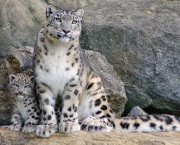 The next stage of complex field research of the Program of study and monitoring of irbis (snow leopard) of South Siberia (Program "Irbis") has been finished. As DV-ROSS was informed by Natalia Remennikova, employee of A. N. Severtsov Institute of problems of ecology and evolution of RAN, this work took place from 25 April to 24 May 2011 on the territory of State natural biospheric preserve "Sayano-Shushenskiy".
The next stage of complex field research of the Program of study and monitoring of irbis (snow leopard) of South Siberia (Program "Irbis") has been finished. As DV-ROSS was informed by Natalia Remennikova, employee of A. N. Severtsov Institute of problems of ecology and evolution of RAN, this work took place from 25 April to 24 May 2011 on the territory of State natural biospheric preserve "Sayano-Shushenskiy".
Together with workers of the preserve, the previously installed photo-traps were checked. From 25 April to 16 May, they documented a snow leopard named "Mongol" by the scientists, who received a satellite collar in March. The irbis was actively marking his territory and exhibited typical behavior of an adult snow leopard male., which is easily seen on the photographs.
Beside Mongol, one adult pregnant irbis female was documented on this territory, as well as a young male. Satellite signals received in real time and showing Mongol's movements confirm the information that the irbis does not leave the borders of his individual territory.
During the field investigations, irbis tracks were counted, excrement samples were collected, as well as fur samples for further molecular-genetic laboratory studies.
Counting of the mountain goats was also performed - the main prey of the snow leopards. The numbers of mountain goats are extremely low, which is not characteristic for this time of the year - South Siberia has had very hot, unfavorable weather. Because of anomalously high air temperature and lack of rain, there is poor growth of plants. Mountain goats, who feed on grassy plants and bushes of the mountain slopes simply do not have enough food. Nevertheless, the scientists hope that this unfavorable situation will not have a bad effect on the well-being of the snow leopard family.
The work of the permanent expedition RAN for the study of animals of the Red Book of Russian Federation and other especially important animals of the fauna of Russia in the Program "Irbis" will continue in the summer of 2011.
The goal of the program of study and monitoring if irbis (snow leopard) of South Siberia (Program "Irbis") is to work out scientific parameters for preservation of irbis in Russia. Its main task is to study the spatial structure of the snow leopard population, and the movements and numbers of these cats on Russian territory, and to design methods of counting the snow leopards. Beside that, reproductive biology of this species is being studied, characteristics of their habitat, feeding habits, as well as distribution and population dynamics of their main prey-species and interactions with other competitive predator species.
One of the chief tasks of the Program is the preparation of new design of strategy of irbis preservation in Russia, and recommendations for irbis protection.
Irbis, or snow leopard (Uncia uncia) is the least studied species of large felids in the world. This is because of the inaccessibility of its habitat as well as the real scarcity of the species. The majority of reports of the biology and ecology of the irbis in scientific literature are based on indirect evidence ( various types of traces of activity; actual tracks and markings). The main characteristics of the population - numbers, density, structural-functional organization - have not been studied. This constitutes a weakness in the strategic and tactical measures in irbis protection .
Description and measurements.
The only species of the irbis genus. A large cat, with body mass of 22-30 kg; body length 103-125 cm; tail length 80-105 cm. Sexual dimorphism not expressed.
External appearance.
Fur of smoky-beige-grey with large round dark-brown spots. Irbis differs from leopard by the grayish hue of fur, very long tail, and thick, fluffy coat. geographic differences in color or body size are not expressed; there is a possibility of two sub-species, but it is often considered a monotypic species.
Distribution.
Snow leopards live in the upper and middle belts of mountains of middle and Central Asia and South Siberia.
Way of life.
Range is in high mountain zones up to 5000 meters above sea level, remains in sub-alpine and alpine zones, on slopes of ravines with thick, bushy undergrowth, on treeless high mountains, alluvial stony scree and snowy mountaintops. They live in family groups from end of summer, through fall and winter. They produce loud vocalizations . Olfactory markings, acoustic and visual signals play a great role in their communication. Dens are in caves or fissures in rocks. Their main prey consists of mountain goats, sheep, roe-deer, wild boars, large rodents, hares and birds. Mating season is in March - May. The young are usually born in May. Gestation period is 93 - 110 days. Each litter consists of 1 to 5 kittens, usually 2 to 3. Kittens (weight 450-500 grams) are born blind, with closed ear passages, helpless (altricial). At 2 months of age they begin to follow their mother. Sexual maturity is reached at 2- 3 years.
Russia is the northernmost area of irbis range. This involves the mountain systems of South Siberia (Altai, Sayan mountains, mountains of Tuva), and the population is 70-150 individuals according to various sources. Ideas about the spatial distribution and structure of this grouping have been formulated as a result of wide scope, but general observations, performed by zoologists of Russian Academy of Sciences, in cooperation with hunters and scientific workers of a number of nature preserves and sanctuaries in 1998-1999, as part of WWF-Russia project in protection of nature of the Altai-Khangai-Sayan region.

